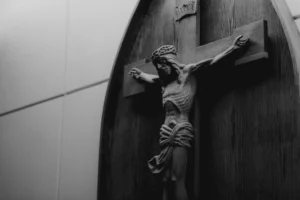It seems that I’ve always experienced the arts as a medium for encountering God. I remember when I was just a girl, for example, flipping through the extra large illustrated children’s Bible. The images were the sermons of my childhood, the gospel I could begin to understand, the images that fostered my imagination of what it meant to belong to the Church and to worship God.
As I’ve grown older I’ve come to believe that the arts are an essential tool for spiritual formation. Perhaps surprisingly, I’ve also come to recognize and appreciate that even art devoid of intentional Christian imagery can have transformative effects on how I understand the human condition and my relationship to God.
Engaging The Artist
At least once a year I lead a spiritual formation retreat on Faith and Art. Participants are invited to spend a day reflecting on how the visual and literary arts can intersect their spiritual lives to draw them closer to God, more attuned to the Spirit and more honest in their faith journey. As word gets around local churches and private Christian schools I begin to receive phone calls and e-mails asking if I am available to offer Sunday morning workshops or weekend retreats on some variation of the theme Faith and Art.
People who attend these retreats and workshops come for one of at least three reasons:
- they don’t consider themselves artists by any means but they are intrigued both by the arts and how to engage the arts for deeper spiritual growth
- they have an age-old passion for the arts, some may even be practicing artists but have struggled to believe the Christian journey and ministry has a place for the arts
- they want to spend some time using a different side of the brain than they are used to in the routine and demands of daily life
But there is one reason that all these retreat participants have in common — they all share a love of the triune God and desire spiritual growth.
This past weekend I led a full-day retreat entitled “The Arts: A Mirror for the Divine,” and a morning workshop on “Art and Prayer.” And it never fails — each time I lead one of these retreats I am moved by how the Spirit uses the arts to bring people to greater spiritual clarity, to honesty before God, to postures of confession, to space of communal storytelling, and to widening openness to divine revelation.
It is difficult to pinpoint what it is exactly that makes our spirits respond in a raw and instinctive way to the arts. Perhaps it is because engaging the arts reminds us that we are made in the image of a divine artist, a God who colored the sky and the flowers; who delights in trees that are pleasing to the eye; who specifically requested “Bezalel … to devise artistic designs” in Exodus 35; who requested that the tabernacle curtains be made of “fine twined linen and blue and purple and scarlet yarns, with cherubim skillfully worked” (Exodus 36:8); not to mention the breathtakingly beautiful detailed tailoring of the priestly vestments in Exodus 39.
The arts not only remind us that we are made in the image of a creator but they invite us to ponder the age-old theological and philosophical understanding that beauty, goodness and truth are inextricably linked with the things of the spirit and the nature of God. And by their very medium the arts instruct us in attentiveness, patience, discipline and the recognition of divine mystery. We are so used to rapid-fire images on our television and computer screens and meaningless cultural icons (consider the big yellow arch) that we subconsciously numb ourselves to the power that images have on our formation.
Stirred by Art
Good art points beyond itself and helps us recognize the human condition and the divine intrusion while calling us to more faithful relationship with the world, relationship that witnesses to the hope and redemption found in the Triune God and offered to us through Christ, the incarnate image that redeems all images grasping for God. In this way art can be a powerful source of truth-telling, sometimes even uncovering the stories we would rather forget.
One painting that comes to mind is Norman Rockwell’s The Problem We All Live With depicting the painstaking attempts to break anti-segregation laws in the Southern educational school system of the 1960’s. Rockwell painted this image after the nation was rocked and torn apart by one brave 6-year-old black child’s willingness to integrate an all-white school in New Orleans in 1960. As that girl, Ruby Bridges, walked to school escorted by federal marshals, listening to the mob of people throw insults her way, she prayed the way her mother had taught her, asking God to be with her and to be with the angry crowd, to forgive them because they didn’t know what they were doing. Painful truth-telling can remind us of our callings to ministries of reconciliation, racial and otherwise.
Art is a way of telling the human story, as we known it through Judeo-Christian lenses, over and over again to help feed the Church’s corporate memory, and it is a way of adding to the story that grounds us as Christians. It speaks to sin and brokenness but also to mystery and revelation.
Two of the images I first fell in love with were Henry Ossawa Tanner’s The Banjo Lesson (1893) and The Thankful Poor (1894). Tanner was a 19th century African American painter and the son of an African American Episcopal Church minister. These paintings impress upon me how the arts can offer gifts of life and hope across socio-economic boundaries, as well as the values of family, patience and gratitude.
A print replica of The Banjo Lesson hangs in my living room. Each time I see it I am momentarily drawn into a world where I am reminded that Christ asks us not to store our treasures where moths enter and decay, a world where Christ says, “Blessed are you who are poor, for yours is the kingdom of God” (Luke 6:20) and a world where the Apostle Paul invites us to “And above all these put on love, which binds everything together in perfect harmony.” (Colossians 3:14).
Art should transform us as well as enrich our notions of God and of humanity. One such painting that offers expanded visions of God’s care for humanity is Rembrandt’s painting, Jacob Wrestling with the Angel. This piece offers deeper insight into what it could mean to wrestle with God. I love how this painting could also be interpreted as a loving intimate embrace. When I gaze at this painting I am alarmingly reminded of times when I have struggled with God in my faith journey and how wrestling with God is full of complexity and challenge … but also divine love and blessing.
But a Foretaste
No finite image can ever fully reveal the infinite God. Artistic images are not to be worshipped as false gods. There has to be the understanding that all human actions are tainted with sin. The reformers (Luther/Calvin) believed that the fall made the image of humanity an imperfect representation of God. Humanity became depraved as a result of the fall. It seems safe to assume that our ability to create is also marred, which is why we can and do create art that draws both to God and away from God. No single piece of art reveals the entire truth but offers more glimpses. No creative representation can ever make the divine visible as the Incarnation.
Yet art is an eternal attempt to receive what God offers us and to speak back to God in all our variety of emotions and settings. There will always be boundaries that cannot be passed, spaces that cannot be accessed. But art brings together the human and the godly, mimicking the incarnation. The godly is the partial revelation that art brings while the human is the fact that it can only be partial and it is susceptible to flaws, and to sin.
Like our encounter with the Incarnate Lord, the arts make us hunger for more, a hunger that should rightfully point us to the Triune God. This is both the hope and the distress of the role of art in the Christian life and faith formation. As a Christian who prays to a God who has promised to hear my prayers and to act for the good of creation, I recognize beauty in the imperfections of our creations, our works of art and our attempts to live faithfully while yet sinners in a broken world. That to me is the human condition.
The works of Marc Chagall, a Jewish artist, have helped me reflect on the multiple ways to respond to the chaos of our broken world. Paintings like The Bride and Groom of the Eiffel Tower, White Crucifixion and The Sources of Music encourage me to look for spaces of order, beauty and hope in the midst of human suffering and within a broken upside down world.
Struggling with Art
The Christian Church has had a love-hate relationship with the arts, oscillating between using the arts for liturgical and educational purposes and dismissing the arts as merely decorative and even offensive and idolatrous. But today there is a growing trend in the use of the arts in congregational life and in the study of the arts in religious educational programs.
Many Christians, however, still wonder what role the arts can play in forming our spiritual lives. The visual arts are still too often relegated as indulgent with little to offer in Christian discipleship. But on the contrary, art reminds us that we are made in the image of a Creator and pulls us into the presence of God while calling us to live as we have been created to live, given the gift of joining in God’s creative activity.
Christ, as the new Adam, reconfigures our relationship to the Triune God, making the divine visible in a completely new way, one that forces us into relationship with that which has been incarnated. A God made flesh redeems the act of human creativity and the possibility of making our human grasping and glimpsing of God more tangible.
Because of the incarnation our confession and worship of God requires that it be more than intellectual. It requires corporeal practices. The sons and daughters of Adam are invited anew to join in God’s creative activity through imaginatively naming new realities of all that has already been given. Poetry, literature, visual art, sculpture, dance and music are all ways of creatively expressing the human condition and creation’s interaction with the Divine.
Artistic expression is a striving for more, a visual hunger for transcendental realities that can only be shaped out of what has already been given to us, unlike God who creates out of nothing. But like our Creator, such creative shaping can also lead to new realities we can live into.
Copyright 2007 Enuma Okoro. All rights reserved.











